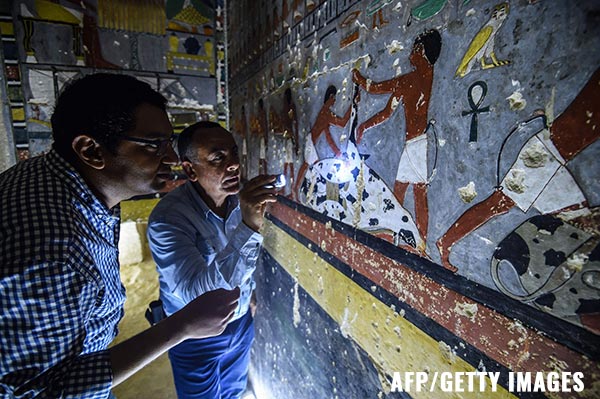Ancient Egyptian tomb reveals GRUESOME murals of cows being slaughtered
10/09/2019 / By Ralph Flores

A recent archaeological mission unearthed more evidence of life in ancient Egypt during the Age of the Pyramids. The dig, led by Mohamed Megahed of the Egyptian Ministry of Antiquities, revealed the remains of a nobleman named Khuwy in a colorful tomb dating back 4,400 years. The discovery was made in Saqqara, an ancient necropolis south of Cairo.
Unlike most tombs, Khuwy’s was unique. The Old Kingdom official, who served under the pharaoh Djedkare Isesi, was laid to rest in an L-shaped tomb with a stunning interior. The limestone walls were adorned with oil and resin to create colorful and ornate images – which have been well-preserved for over four millennia. The hieroglyphs in the tomb indicate burial offerings, as well as the official’s many titles, which include “overseer of the khentiu-she of the Great House,” “Great one of the ten of Upper Egypt” and “Sole friend.” According to Emilie Martinet, an Egyptology researcher from Paul Valery University of Montpellier in France who wasn’t part of the team, the titles indicate that Khuwy was a senior administrator in the pharaoh’s court.
Ancient pyramids and chopped-up cows
The tomb complex, which is found next to a pyramid complex for Djedkare, features a corridor that descends to a vestibule. The vestibule, which is shaped like a hallway, has an entrance on the southern wall. Here, paintwork depicting Khuwy at an offering table for the gods can be found on the wall, as well as other intricate images – including a mural which shows scenes of men slaughtering cows and carrying cuts of meat. The northern wall of the tomb, meanwhile, boasts of a design inspired by the architectural blueprint of the northern pyramids. Other scenes in the antechamber include a view of a palace facade on the west wall and an offering list on the east wall.
The team also uncovered the burial chamber. However, this only contained what remains of a white limestone sarcophagus, which, according to Megahed, may be due to ancient tomb robbers. The researchers still found Khuwy’s remains under the rubble, together with oils and resin used during the mummification process.
“The discovery of this tomb stresses the importance of Djedkare’s era, and the end of the Fifth Dynasty in general,” Megahed said. (Related: Unlocking the secrets of Ancient Egypt: Archaeologists uncover dozens of mummified animals in the Tomb of Tutu.)
Discovering the owner of the complex
The team also studied a pyramid beside that of Djedkare’s and found evidence of it belonging to a little-known queen named Setibhor. The queen’s name was discovered, in sunken relief, on a red granite column within the pyramid, which read: “The one who sees Horus and Seth, the great one of the hetes sceptre, the great of praise, king’s wife, his beloved Setibhor.”
The queen’s pyramid, located beside the pharaoh’s, is considered the largest ever built for an Old Kingdom queen and includes features that can only be found in pyramid complexes for kings – establishing her status as Djedkare’s wife.
“The large size of the pyramid complex of queen Setibhor and her title of [king’s] wife indicate perhaps her direct intervention in helping her husband, king Djedkare [Isesi], ascend the throne of Egypt,” according to the Czech Institute of Egyptology.
The pharaoh Djedkare Isesi was a ruler in the latter part of the Fifth Dynasty of Egypt. He was one of the most influential ancient Egyptian kings, with great reforms made in religion and government during his time. Records of his actual reign are unclear; some scholars say that he ruled for almost 40 years while others say it was only 28 years. Djedkare’s reign saw the increase in authority of provincial rulers and trade missions to many African countries.
Learn more interesting historical facts at Artifacts.news.
Sources include:
Tagged Under: ancient art, Ancient Egypt, ancient history, antiquities, artifacts, cows, discoveries, Djedkare Isesi, Egyptology, hieroglyphics, Khuwy, murals, offerings, pharaoh, pyramids, research, Setibhor, Slaughter
RECENT NEWS & ARTICLES
COPYRIGHT © 2017 RESEARCH NEWS



















